Archive
Unboxing SIO2SD interface by Pigula
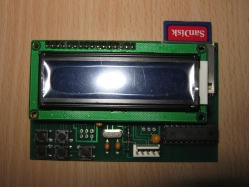
Autopsy:
Testing the SIO2SD interface for Atari
The SIO2SD is a device that allows you to load games/applications into any 8-bit Atari XL/XE computers via SIO interface from SD/MMC cards.
Device abilities:
- Works with SD (not SDHC) and MMC(FAT12,FAT16 and FAT32 formats)
- Handles ATR (rw), XFD (ro) and COM/XEX (ro) file types.
- 16×2 LCD display allows to “walk” catalog tree and choose files to load.
- Handles SIO with turbo (allows to set speed index from 1 to 16, default is 6 (69kb/s), in versions 1.x speed index was always 10 (51kb/s))
- All densities with 128B and 256B sectors, including 16MB disks.
- Handles drives D1 to D8.
- Can be configured using ATARI (it’s possible to load configuration tool directly from MCU flash memory, so no SD card is needed)
SIO2SD in Action:
source: sio2sd.gucio.pl marcinprusisz.pl
Atari 800 XL (Boxed)
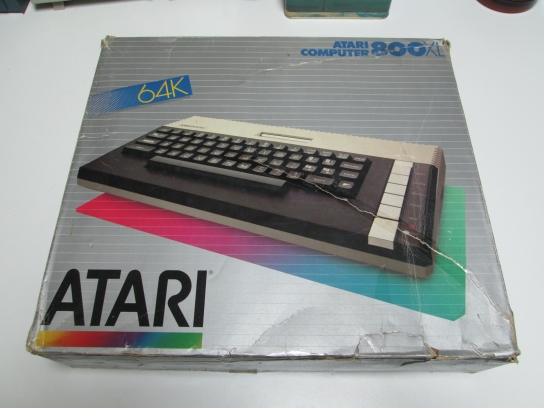
Autopsy:
The Atari 800XL was the third version of the Atari 8-bit line of computers introduced in 1983. The system contained a full 64K of memory, had all the standard VLSI chips (Antic, GTIA, Pokey, PIA) and was in a smaller and more compact design. The keyboard was good, not as good as the 1200XL keyboard, but it had a solid feel to it.
The cartridge port had been move to the top center of the system and used special metal spring loaded doors to allow the insertion and removal of ROM cartridges. This system of spring loaded doors also kept dirt and objects from falling into the cartridge slot when it was not occupied.
Overall the system is basically a cost reduced Atari 800 with a fuzzier picture. The system came with built-in diagnostics and a HELP key. The OS was still slightly incompatible with many original Atari 400/800 software titles, but Atari began to distribute a “Translator” disk which would load up a 400/800 compatible OS into memory so that the 800XL could support those programs.
A never version of the 800XL was being readied called the 800XL-F which included the new “FREDDY” memory management chip that would have allowed for more use of free memory for programs and geater use of graphics by the “ANTIC” video processor.
from: atarimuseum.com
Atari XC12 Program Recorder (Tape drive) Boxed
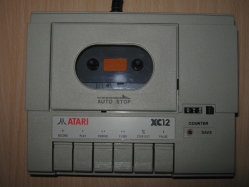
Autopsy:
from Wikipedia:
This is a Atari XC12 tape drive (small model like the 1010, sold worldwide). Similar models were released, mainly in Eastern Europe. These included:
- XCA12 (same case as XC12)
- CA12 (same case as XC12)
- XL12 tape drive (an XC12 with minor changes)
- XC13 – “T2000 ready” version of XC12
source: wikipedia
Atari 65 XE (Color Fixed)
My Atari 65 XE can show only Black & White pictures, i have found the problem when i have open it, someone has put a screw in the wrong place and the trimmer which adjust the color is broken.
Atari 65 XE (Boxed) + XEGS Cartridges Games (Boxed)
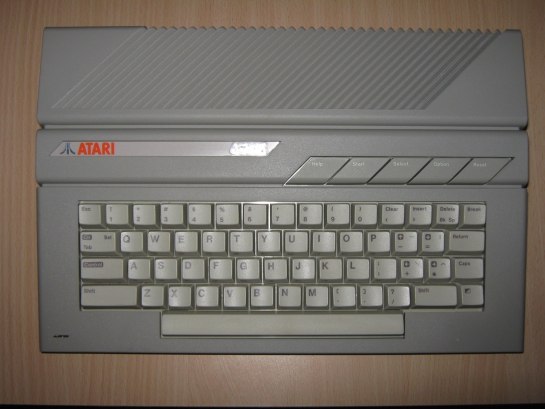
Autopsy:
from Wikipedia:
Jack Tramiel’s Atari Corporation produced the final machines in the 8-bit series, which were the 65XE and 130XE (XE stood for XL-Expanded). They were announced in 1985, at the same time as the initial models in the Atari ST series, and resembled the Atari ST. Originally intended to be called the 900XLF, the 65XE was functionally equivalent to the 800XL minus the PBI connection.
The 65XE (European version) and the 130XE had the Enhanced Cartridge Interface (ECI), a semi-compatible variant of the Parallel Bus Interface (PBI). The 130XE shipped with 128 KB of memory, accessible through bank-selection.
An additional 800XE was available in Europe (mostly Eastern Europe), which was essentially a 65XE repackaged in order to ride on the popularity of the original 800XL in Europe. Unfortunately, the 65XE and 800XE machines sold in Eastern Europe had a buggy GTIA chip, specifically those machines made in China in 1991.
Finally, with the resurgence of the gaming industry brought on by Nintendo, Atari Corp. brought out the XE Game System (XEGS), released in 1987. The XE Game System was sold bundled with a detachable keyboard, a joystick and a light gun (XG-1), and a couple of game cartridges (Bug Hunt and Flight Simulator II). The XE Game System was essentially a repackaged 65XE, and was compatible with almost all Atari 8-bit software and hardware as a result. Bad marketing and a lack of newer releases hampered sales.
On January 1, 1992, Atari corp. officially dropped all remaining support of the 8-bit line.
source: wikipedia
Atari 600 XL Boxed
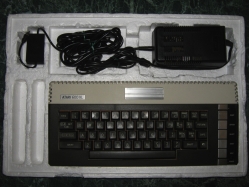
Autopsy:
from old-computers Homepage:
The Atari 800XL, together with the 600XL, were successors of the Atari 400/800 series and the unsuccessful Atari 1200 XL in a more compact case. They could use almost the same software, just so long as the program was written correctly, because of some slight differences between OS versions.
The 800XL had 64 KB of RAM, two joystick ports and kept all the custom chips (Pokey, GTIA, Antic) of the previous models. It also featured the new Parallel Bus Interface (PBI) providing high speed access to the system bus. The new version of the graphic Antic chip offered 16 graphics modes instead of 12 for the 800.
An enhanced version, called 800XLF, appeared in summer 1984. It was equipped with the new “Freddie” chip which allowed faster memory management, especially for graphics display. This version was released in Europe with SECAM video interface.
Alongside the Commodore 64 and the Apple II, the 600 and 800XL were among the most popular home computers.They would be replaced in 1985 with the XE series when Atari launched the ST.
Atari Flashback (Mini 7800)
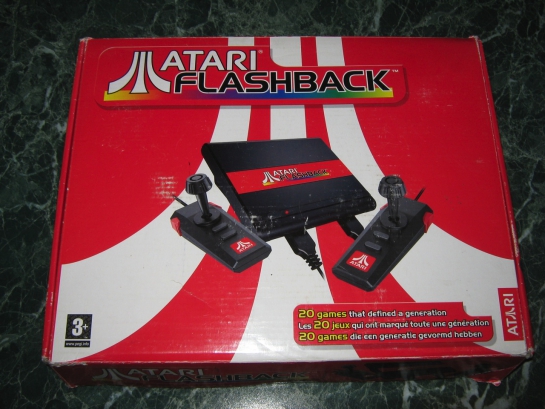
Autopsy:
from Wikipedia:
The Atari Flashback was released in 2004. The console resembled an Atari 7800 in appearance, and came with a pair of controllers which resembled those of the Atari 7800 but were slightly smaller.
The system had twenty games built-in, all originally developed by Warner Communication’s Atari Inc. and Atari Corp. for the 2600 and 7800 game systems. The games which originally required analog paddle controllers were made to work with the included joysticks. It was designed by Atari veteran Curt Vendel, whose company Legacy Engineering Group designs other home video game and video arcade products.
Atari Inc. gave Legacy Engineering ten weeks to design the product, produce its games, and ready it for the 2004 Winter holiday season. The Atari Flashback was based on “NES-on-a-chip” hardware, not resembling either of the Atari systems which the Flashback was supposed to represent. As a result, the games it contained were ports and differed in varying degrees from the original games, and therefore the Flashback was unpopular with some purists.
source: wikipedia
Atari Paddle
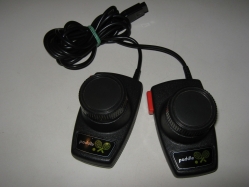
from Wikipedia:
A paddle is a game controller with a round wheel and one or more fire buttons, where the wheel is typically used to control movement of the player object along one axis of the video screen. A paddle controller rotates through a fixed arc (usually about 330 degrees); it has a stop at each end.
The paddle wheel is usually mechanically coupled to a potentiometer, so as to generate an output voltage level varying with the wheel’s angle relative to a fixed reference position. A paddle is thus an absolute position controller. That is, without any previous knowledge, the sensor can be read and the result directly indicates the position of the paddle knob. This is in contrast to a quadrature encoder-based device or “spinner”.
source: wikipedia
Atari 1040 STf TOS Eprom Upgrade v1.04
Atari ST replace Epson broken Floppy Drive with a Teac FD235 HF
Atari 1040 STf with Mouse, RGB Cable and User Manual
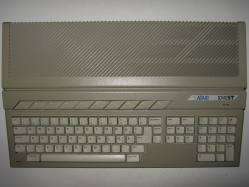
Autopsy:
from Wikipedia:
The Atari ST is a home/personal computer that was commercially available from 1985 to the early 1990s. It was released by Atari Corporation in 1985. The “ST” officially stands for “Sixteen/Thirty-two”, which referred to the Motorola 68000′s 16-bit external bus and 32-bit internals.
The Atari ST was part of the 16/32 bit generation of home computers, based on the Motorola 68000 CPU, with 512 KB of RAM or more, and 3½” single density double sided floppy disks as storage (nominally 720KB). It was similar to other contemporary machines which used the Motorola 68000, the Apple Macintosh and the Commodore Amiga. Although the Macintosh was the first widely available computer with a graphical user interface (GUI), it was limited to a monochromatic display on a smaller built-in monitor.
Preceding the Amiga’s commercial release by almost two months, the Atari ST was the first computer to come with a fully bit-mapped color GUI, using a version of Digital Research’s GEM released that February. It was also the first home computer with integrated MIDI support.
 The ST was primarily a competitor to the Apple Macintosh and the Commodore Amiga systems. This platform rivalry was often reflected by the owners and was most prominent in the Demo Scene. Where the Amiga had custom processors which gave it the edge in the games and video market, the ST was generally cheaper, had a slightly faster CPU, and had a high-resolution monochrome display mode, ideal for business and CAD.
The ST was primarily a competitor to the Apple Macintosh and the Commodore Amiga systems. This platform rivalry was often reflected by the owners and was most prominent in the Demo Scene. Where the Amiga had custom processors which gave it the edge in the games and video market, the ST was generally cheaper, had a slightly faster CPU, and had a high-resolution monochrome display mode, ideal for business and CAD.
Thanks to its built-in MIDI ports it enjoyed success as a music sequencer and controller of musical instruments among amateurs and professionals alike, being used in concert by bands such as Tangerine Dream, Fatboy Slim and 90s UK dance act 808 State. In some markets, particularly Germany, the machine gained a strong foothold as a small business machine for CAD and Desktop publishing work.
The ST was later superseded by the Atari TT and Falcon computers. Since Atari pulled out of the computer market there has been a market for powerful TOS-based machines (clones). Like most “retro” computers the Atari enjoys support in the emulator scene.
source: wikipedia atari-forum
Some Cartridges: ATARI 2600 – XL 800 – Pong Clone – MSX Cassette
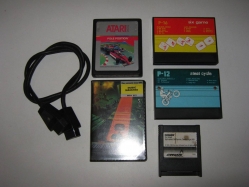
Autopsy:
Description:
- 2 x Pong Clone Cartridges (AY 3 8765 GI Chip)
- 1 x Facemaker Cartridge for Atari XE XL 800.
- 1 x Pole Position for Atari 2600.
- 1 x Music Maestro Cassette for MSX 64k.
- 1 x Unknown Cable Rare SIO Cable for ATARI.
Some Cartridges for Atari 2600 & 7800
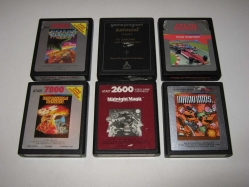
Cartridges:
- Desert Falcon (Atari 7800)
- Impossible Mission (Atari 7800)
- Midnight Magic (Atari 2600)
- Surround (Atari 2600)
- Pole Position (Atari 2600)
- Mario Bros (Atari 2600)
Atari 7800 ProSystem with RGB Encoder inside (Peritel version)
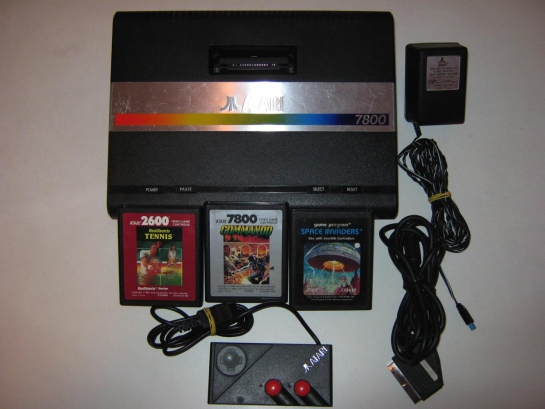
Autopsy:
from Wikipedia:
The Atari 7800 ProSystem, or simply the Atari 7800, is a video game console re-released by Atari Corporation in June 1986.
The original release had occurred two years earlier under Atari Inc. The 7800 was designed to replace Atari Inc.’s unsuccessful Atari 5200 and later to re-establish Atari Corp.’s market supremacy against Nintendo and Sega.
With this system, Atari Inc. addressed all the shortcomings of the Atari 5200: it had simple digital joysticks; it was almost fully backward-compatible with the Atari 2600; and it was affordable (originally priced at US$140).
source: wikipedia




























































































































































Recent Comments